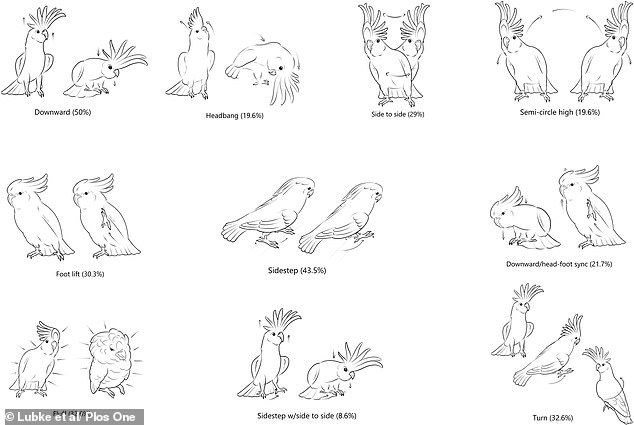If you thought head banging and body rolls were limited to rock concerts or hip-hop clubs, you’d be mistaken.
Experts have discovered that cockatoos have at least 30 different dance moves in their repertoire – including these two signature steps.
The routines – of which 17 are newly identified – can even be performed without music.
And it shows that the birds’ dancing skills are far more common, complex and varied than previously thought.
Researchers from Charles Sturt University in Australia and Bristol University in the UK analysed 45 videos posted on social media that showed captive cockatoos dancing.
Some of the newly-documented moves include the semi-circle high, the downward head/foot sync, the fluff and the jump turn.
The researchers found that some birds also performed their own individual dance moves, often by combining several of the movements in unique ways.
The most common move, performed by 50 per cent of birds, was the ‘downward’ which involved the head bobbing in a downward motion while keeping the eyes facing forward.

The most common move was the ‘downward’, performed by 50 per cent of the birds in the study

Here, Snowball the Cockatoo performs the ‘foot lift’ move. The cockatoo, who was not involved in this study, has previously helped researchers analyse dancing in animals
Next came the ‘sidestep’, carried out by 43.5 per cent of cockatoos. Other popular moves included the ‘fluff’ which involves puffing up their feathers, and the headbang.
Overall, movements involving just the head were more common while the least common movements were those involving just wings.
Next, the researchers investigated dancing behaviour in six cockatoos from three different species housed at Wagga Wagga Zoo in Australia.
They played the birds music, an audio podcast, or no audio, and found that all birds performed dance moves, regardless of whether music was being played or not.
The study, published in the journal Plos One, revealed that dancing behaviour is present in nearly half of all species of cockatoo.
The authors say that further research is needed to determine whether the birds enjoy dancing and whether encouraging this behaviour could improve welfare for captive cockatoos.
Professor Rafael Freire said: ‘The similarities with human dancing make it hard to argue against well-developed cognitive and emotional processes in parrots, and playing music to parrots may improve their welfare.
‘Further research would be beneficial to determine if music can trigger dance in captive birds and serve as a form of environmental enrichment.’

Snowball the cockatoo performing the ‘side-to-side’ head movement, which nearly a third of birds in the current study performed

While head banging might seem more at home at a rock concert, it turns out cockatoos perform it too. Pictured: Snowball the cockatoo showing off his dance moves
Researcher Natasha Lubke added: ‘As well as supporting the presence of positive emotions in birds and advancing dance behaviour as an excellent model to study parrot emotions, the work suggests that playing music to parrots may provide a useful approach to enrich their lives in captivity, with positive effects on their welfare.’
Several years ago, a viral cockatoo named Snowball was enlisted to help scientists study dancing in animals after becoming a YouTube sensation.
Read More
Who’s a pretty clever boy then! Cockatoos pass the ‘tool kit test’ after showing they can plan which tools are needed to get hard-to-reach food – a feat only achieved by humans and chimpanzees

The talented bird managed to wow researchers with 14 different moves as he bopped along to 80s classics.
The sulphur-crested cockatoo was filmed swinging from side to side, lunging and lifting his foot as he grooved to Another One Bites The Dust and Girls Just Want To Have Fun.
Snowball showed a more diverse range of motions when bopping along to Cyndi Lauper’s 1983 classic, however.
Scientists led by a team from the University of California, San Diego believe his ‘remarkably diverse spontaneous movements’ show that dancing is not limited to humans but a response to music when certain conditions are present in the brain.


